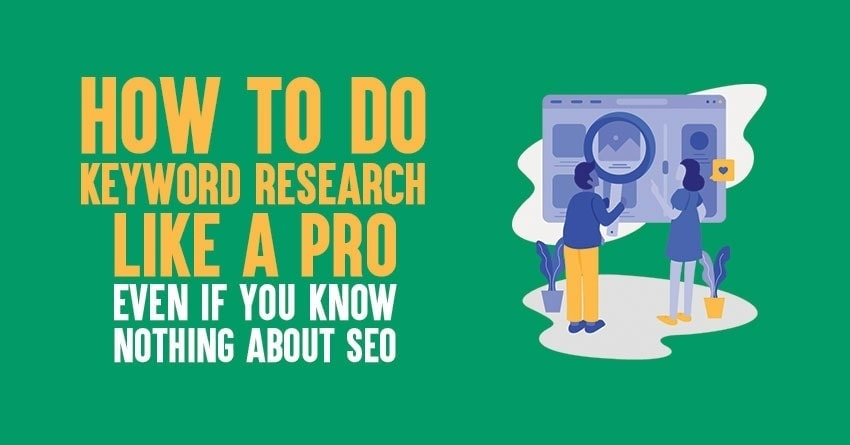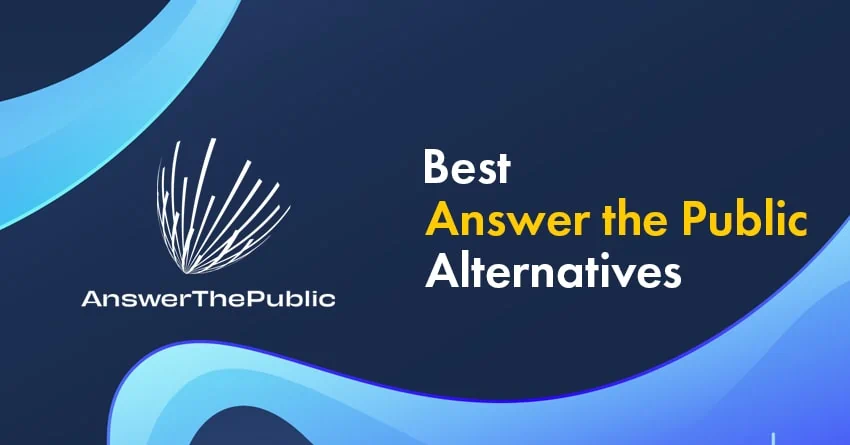In B2B, keyword research plays a huge role in better rankings and higher conversions.
Successful B2B research is all about reaching the right people at the right time. It’s important for SEO success in industries with long sales cycles.
If you want more leads, highly relevant visitors, and to build trust with your ideal customers, B2B keyword research is essential.
In this guide, you’ll learn how to identify high-intent B2B keywords, understand the stages of the buyer’s journey, analyze competitor strategies, and avoid common mistakes.
Table of Contents
- What is B2B Keyword Research?
- The Purpose of B2B Keyword Research
- What Makes B2B Keyword Research Different from B2C?
- Step-by-Step Process for Effective B2B Keyword Research
- How to Identify High-Intent Keywords in B2B?
- Mapping Keywords to the B2B Sales Funnel
- Mistakes to Avoid in B2B Keyword Research
- Final Tips for a Winning B2B SEO Strategy
- FAQs | B2B Keyword Analysis
What is B2B Keyword Research?
B2B keyword research is the process of identifying keywords or phrases that business buyers use to find products for their organizations.
For example, if you sell office chairs in bulk, keywords could include “bulk office chairs” or “wholesale office furniture.”
The key difference between traditional keyword research and B2B keyword research is who you’re targeting.
In B2B, a company might search for “enterprise email marketing platform” (targeting large-scale business solutions). In general keyword research, an individual might search for “best email tools” (looking for use in personal or small businesses).
The Purpose of B2B Keyword Research
B2B keywords help attract high-quality leads, generate relevant search traffic, and drive better conversions.
Some of the primary benefits of B2B keyword research include;
Helps target relevant decision-makers
Reaching the right people is the key to generating more B2B sales.
With B2B keywords, you can attract highly relevant decision-makers. For example, a keyword like “best CRM for Marketing Directors” or “cybersecurity software for CTOs”.
Aligns content with buying intent across the funnel
You need to understand the buyer’s journey and where he is in the funnel: awareness, consideration, or decision stage. It can be done easily with B2B research.
For example, someone searching for a keyword like “what is CRM software” is likely in the awareness stage, whereas a keyword term like “HubSpot CRM pricing” indicates they are ready to make a purchase.
Enables better product positioning in search
B2B keyword research can show you the exact words buyers and competitors use.
For example, if people search “AI-powered email marketing software,” marketing your tool as an AI-driven tool makes it more relevant. Similarly, targeting a keyword like “Mailchimp alternatives” helps you reach B2B buyers who are already comparing different tools.
What Makes B2B Keyword Research Different from B2C?
B2B keyword research is different from B2C because it focuses on user intent, sales cycles, and audience.
- B2B keywords primarily target businesses and professionals
- B2C keywords focus on individual customers
B2B keywords are intent-driven, not just volume-driven. For example, a B2C keyword may be “buy running shoes online,” while a B2B search may be “best CRM software for small businesses.”
B2B keywords involve multi-step, multi-stakeholder journeys. So, the buying process is longer than B2C and usually involves many people (like the CTO, CFO, or Marketing Head).
B2B keyword research often needs in-depth topic research on specific industries and niche markets, whereas B2C keyword research focuses on high-volume keyword terms to reach more people. For example, “best running shoes for men”.
Step-by-Step Process for Effective B2B Keyword Research
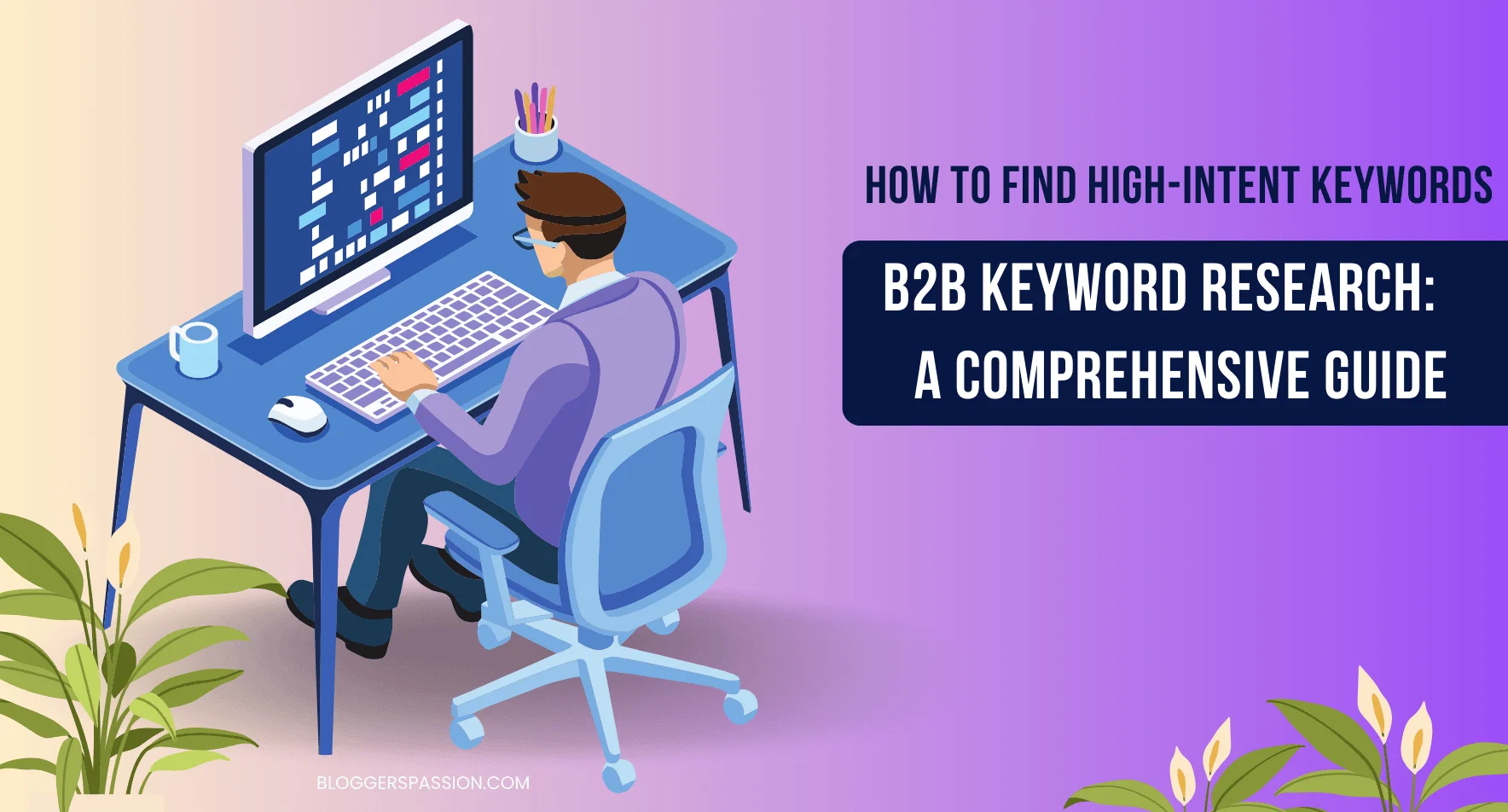
Want to find the right keywords to attract high-quality B2B leads? Here’s a practical step-by-step process to begin your B2B keyword research.
Step 1: Define Your Ideal Customer Profile (ICP)
Before searching for keywords, you need to know exactly who you want to reach.
You need to define your ideal customer profile. That’s how you can determine the type of person or business that is interested in buying your product or service.
A good ideal customer profile includes:
- The industry or niche they belong to
- Company size (employees, revenue, etc.)
- Job role or decision-maker
- Their main goal or pain point
Let’s say you’re selling SEO software to B2B companies.
Here’s what the ideal customer profile (ICP) looks like;
- Industry/Niche: Small eCommerce businesses selling fitness products online (gym equipment, apparel, etc.)
- Company Size: 10 to 15 employees, yearly revenue between $200,000 to $1 million
- Job Role/Decision-Maker: Marketing manager or business owner who handles online sales
- Main Goal/Pain Point: Wants to get more organic traffic from Google but doesn’t have the budget to hire an in-house SEO agency.
Are you getting it? You need to be crystal clear about who your ideal customer is before conducting keyword research.
Once you have this profile, finding the right keywords becomes much easier. You’ll know exactly which search terms to target to attract the right people from Google.
Step 2: Discover Pain Points and Topics
Find out what problems or pain points your ideal customer faces and what topics matter most to them.
For example, if you sell SEO software, you might discover your target customer struggles with pain points like;
- Low search traffic
- Unable to afford expensive SEO agencies
- Competitors are ranking for keywords above them
Want to improve your Google rankings? Here are some useful SEO tips and tricks to help you get more search traffic in 2026.
How to find these pain points?
You can check platforms like LinkedIn, Reddit, or niche forums to identify the everyday struggles your ideal customer faces.
Have a look at this thread on Reddit.
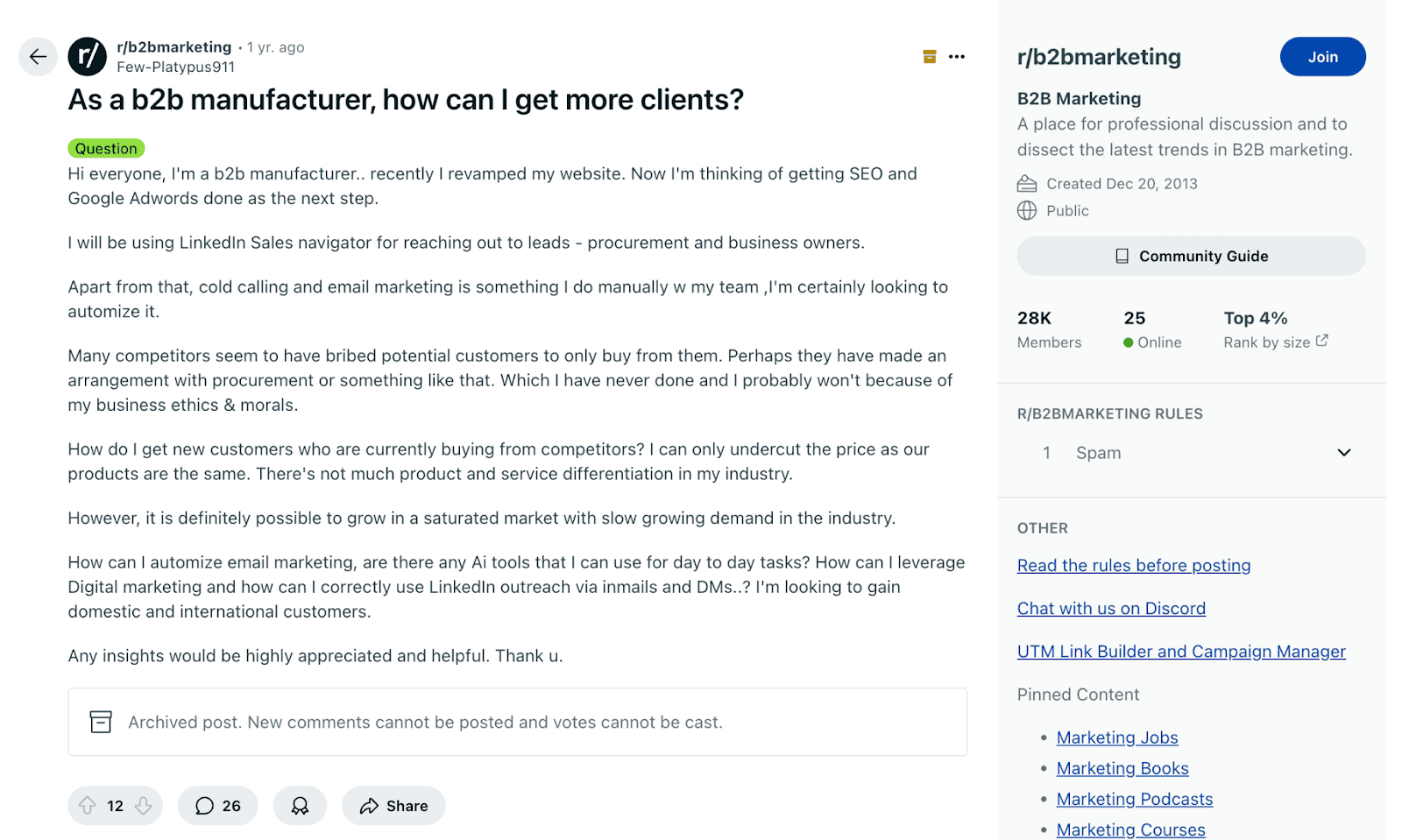
In this Reddit thread, a B2B manufacturer discusses struggling to win new customers, competing with competitors, and seeking to automate cold calling and email marketing.
By reading posts like this, you can easily spot specific problems you can solve.
For example, the above person has pain points like “getting more customers in B2B,” “email automation tools for manufacturers,” and “how to stand out in a crowded market.”
These pain points can become the seed ideas for your keyword research and content plan.
The key here is to really understand what your audience is struggling with. So, pay close attention to their pain points before you even think about keyword research.
Did you know what topic Clusters are? Topic clusters group content around a central topic (pillar) and related subtopics, all linking to each other for better SEO.
Step 3: Use Keyword Research Tools Effectively
Keyword research tools are mandatory, as they can help you.
- Understand what your target audience is searching for
- How competitive those keyword terms are
- Which keywords can drive the most traffic
- What CPC (Cost Per Click) each keyword has
There are lots of free keyword research tools available, including AnswerThePublic, KeywordTool.io, Ubersuggest, etc.
These tools show you monthly search volume, keyword difficulty, and even related phrases you might not have considered.
The key to getting the most out of keyword research tools is to identify the intent behind each keyword. There are four types of keywords, which include;
- Informational: When people want to learn something. Example: “What is SEO?”
- Navigational: When people look for a specific site. Example: “YouTube login”
- Commercial: When people compare before buying. Example: “Best SEO tools under $100”
- Transactional: When people are ready to make a purchase. Example: “Buy iPhone 16 online”
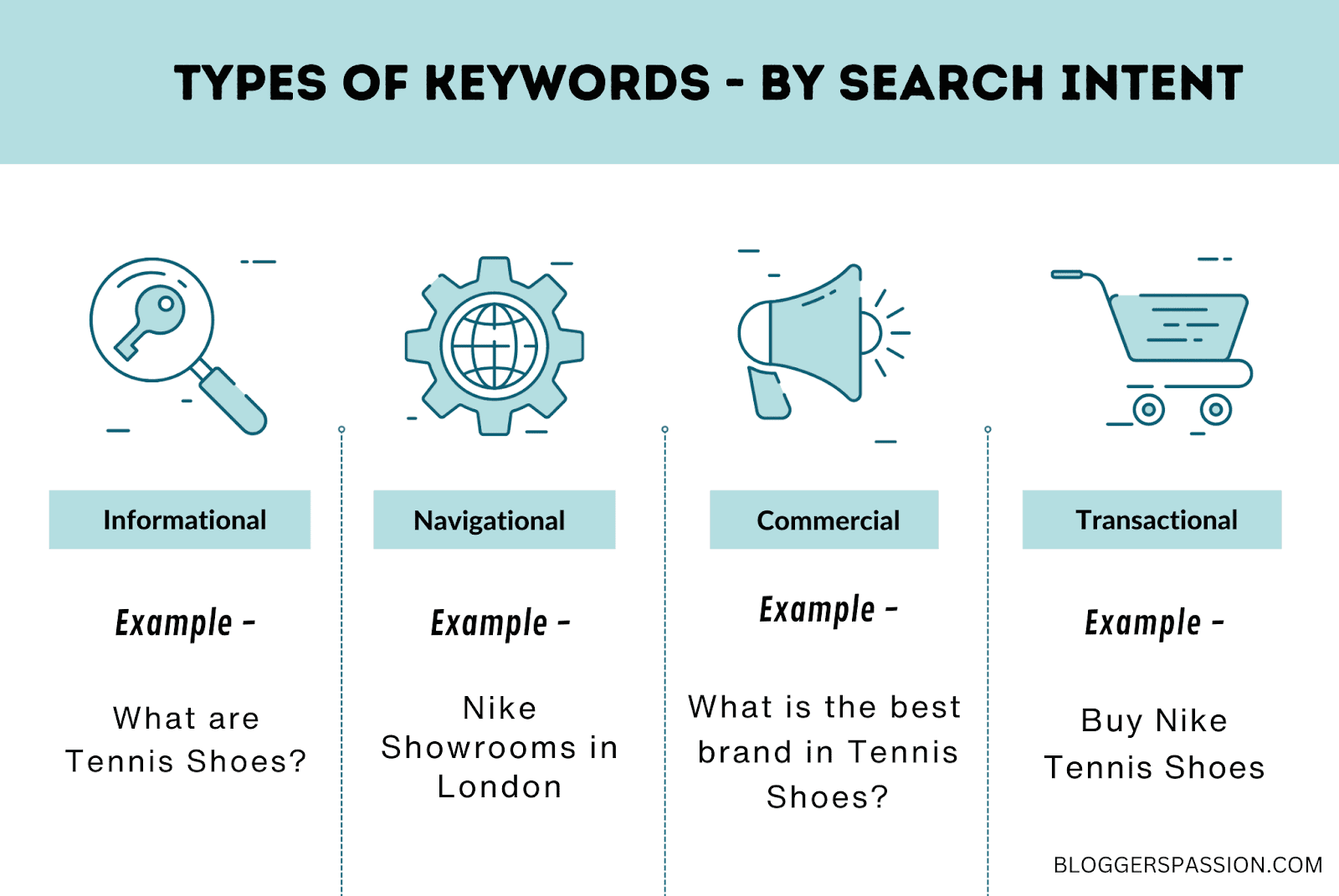
You can use tools like Semrush to help identify the intent behind each keyword.
Here’s what it looks like;
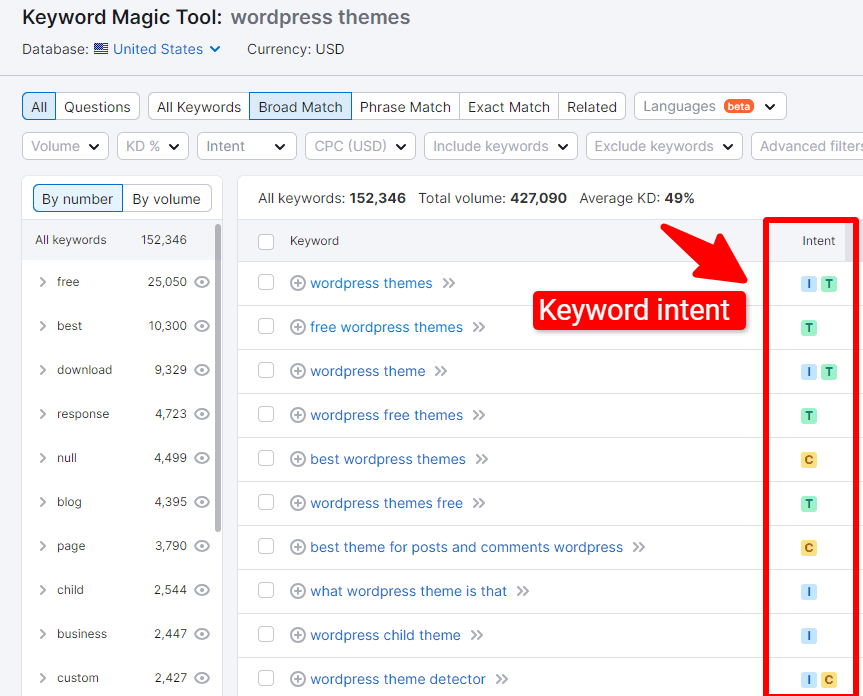
As shown above, Semrush doesn’t just provide you with relevant keyword ideas; it also reveals the search intent behind them, helping you understand what users are truly looking for.
It also offers a free trial, which you can claim using the following link.
For more details on its features and unique offerings, read our unbiased Semrush review.
Step 4: Focus on Long-Tail, High-Intent Keywords
Want to attract high-quality leads and search visitors to your B2B business? Then, you need to target long-tail, high-intent B2B keywords.
Instead of targeting broad keyword terms like “CRM software” (highly competitive), you could focus on “best CRM software for remote IT teams” (less competitive but highly specific).
Long-tail and highly specific keywords can also help you understand your target buyer’s journey.
You can also use free tools like Ubersuggest for finding long-tail keywords that match buyer intent.
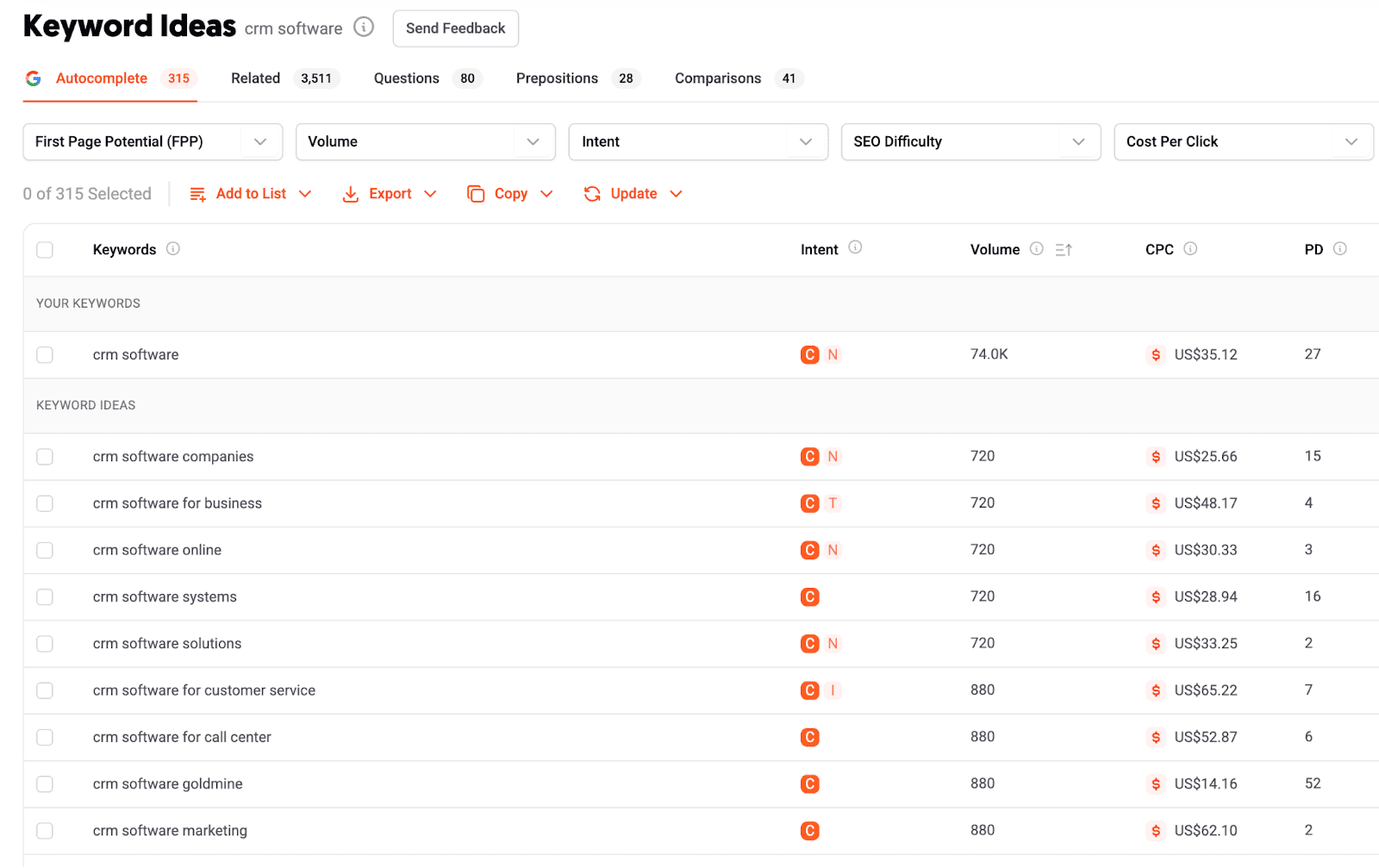
For example, instead of targeting a broad keyword like “CRM software” (74,000 searches, CPC $35.12), you can go after more specific, high-intent keywords such as “CRM software for customer service” (880 searches, CPC $65.22) or “CRM software for call center” (880 searches, CPC $52.87).
These long-tail terms may have lower search volume, but they often have stronger purchase intent and less competition.
You can also target the “People Also Search for” section keywords to target long-tail queries that buyers search for. These keywords are often question-based long-tail keywords that show specific intent and attract more relevant users.
Here’s an example;
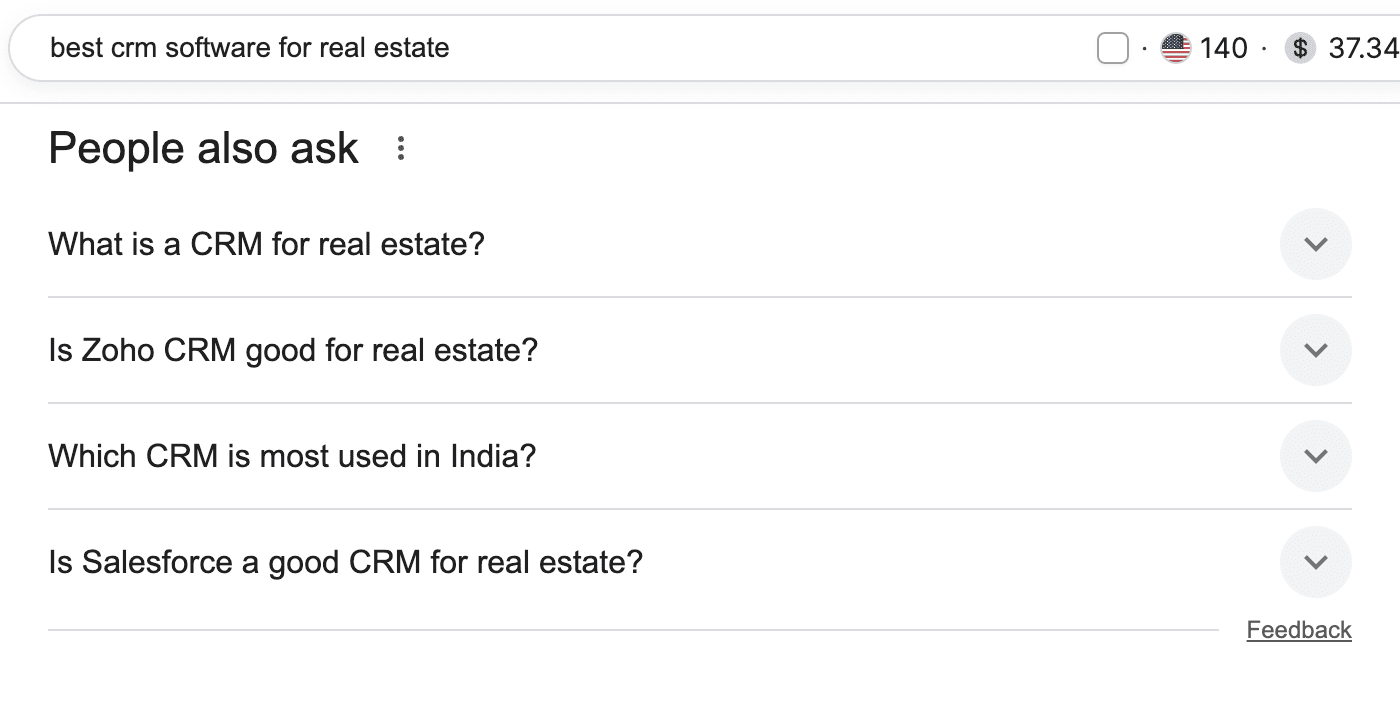
How to Identify High-Intent Keywords in B2B?
The most effective way to boost your B2B conversions and attract high-quality leads from Google is to identify keywords closer to the conversion point.
Here are some of the ways to identify high-intent keywords in B2B;
Recognize Buying Modifiers
When conducting keyword research, look for keyword modifiers that indicate a business is ready to make a purchase, compare, or take action.
Examples include “buy,” “pricing,” “demo,” “free trial,” “best,” or “vs.”
For instance, “Semrush software pricing” is a buyer intent keyword rather than “what is Semrush,” because the user is considering the pricing of the tool before purchasing.
Here’s an excellent illustration of understanding different buying intents by users:
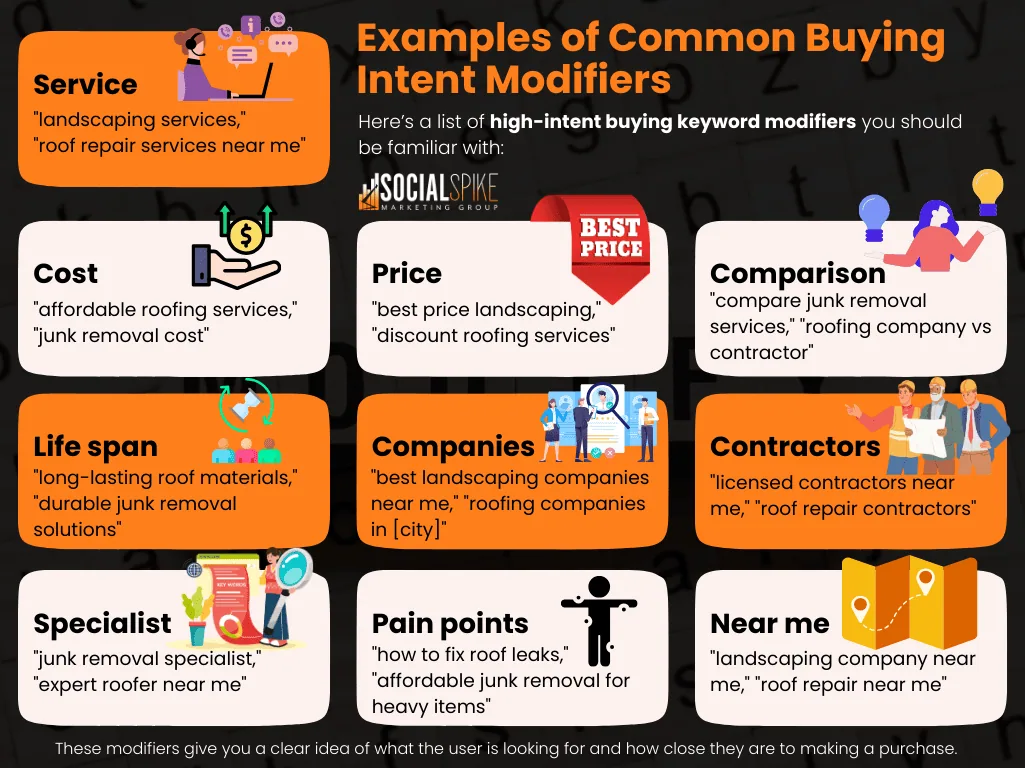
Use Competitor Keyword Analysis for Intent Signals
Another way to identify high-intent keywords in B2B is to analyze what keywords your competitors are ranking for.
Make sure to use terms like “alternatives,” “reviews,” or “compare” to identify which pages generate high-intent traffic to your competitors. That’s how you can create similar comparison content to capture those leads.
We often use Semrush for in-depth competitor analysis as it shows which keywords competitors rank for, their traffic sources, and the gaps we can target.
Here’s an example of HubsSpot’s high-intent keywords that contain the modifier “review”.
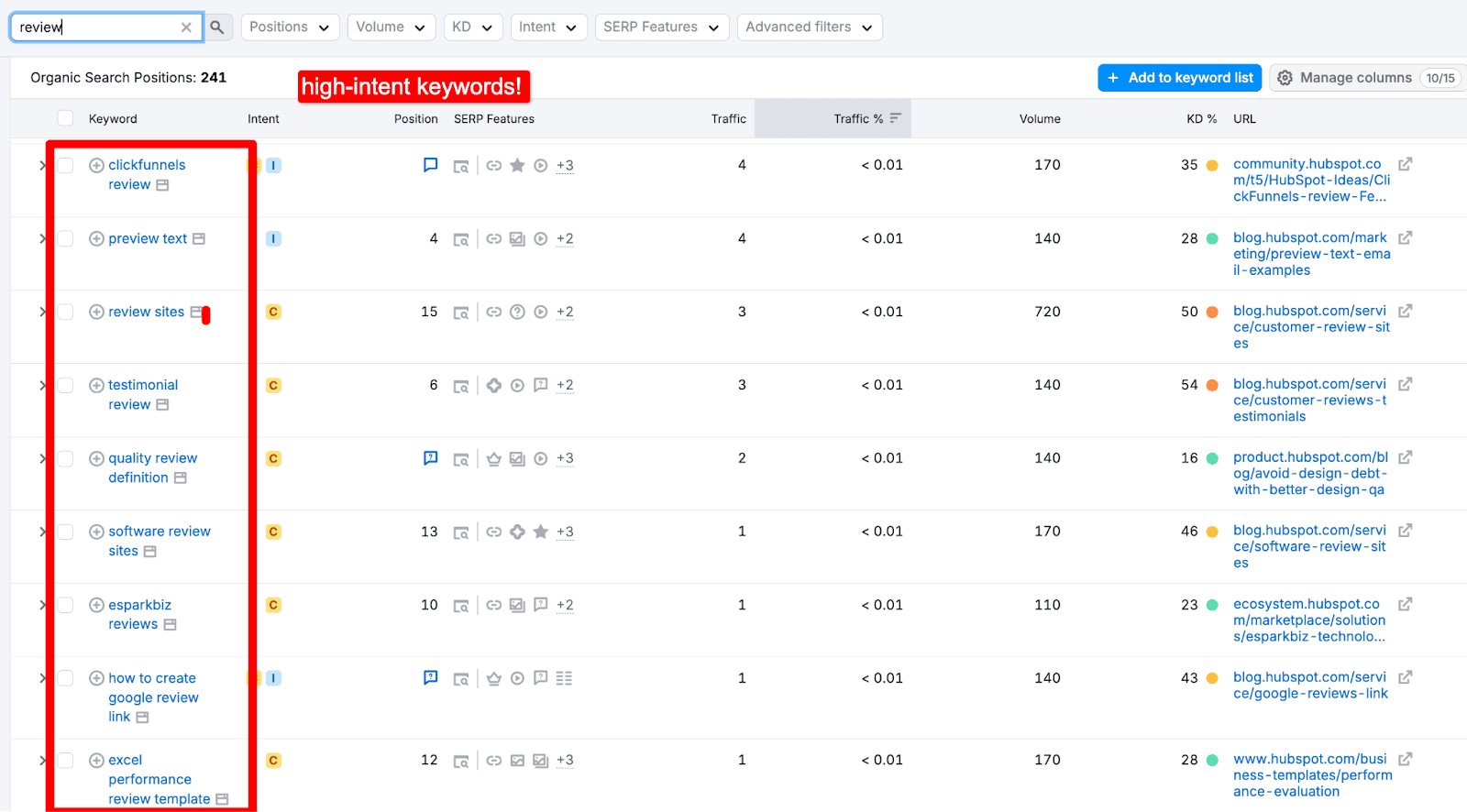
Validate Using SERP Features and Search Intent
The simplest way to identify high-intent keywords is to do a SERP analysis on Google.
- If Google displays product pages, reviews, and pricing tables for a keyword term, it indicates that the keyword has transactional intent. Example: “best B2B lead generation software”
- If Google shows guides, blog posts or how-to content, the keyword has informational intent. Example: “how to generate B2B leads”
Mapping Keywords to the B2B Sales Funnel
Successful B2B keyword research is all about identifying keywords that match the buyer’s journey.
The buyer’s journey is the process someone goes through before buying, usually:
- Awareness (realizing they have a problem)
- Consideration (looking for solutions)
- Decision (choosing a product/service)
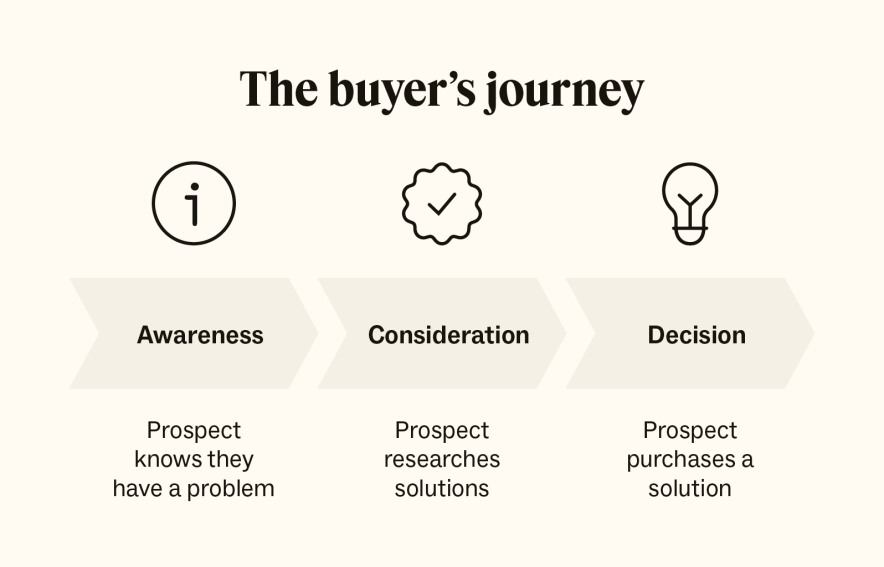
For example:
- Awareness: “Why is my website slow?”
- Consideration: “Best website speed tools”
- Decision: “Buy WP Rocket speed optimization tool”
A B2B sales funnel has three stages:
- TOFU (Top of Funnel)
- MOFU (Middle of Funnel)
- BOFU (Bottom of Funnel)
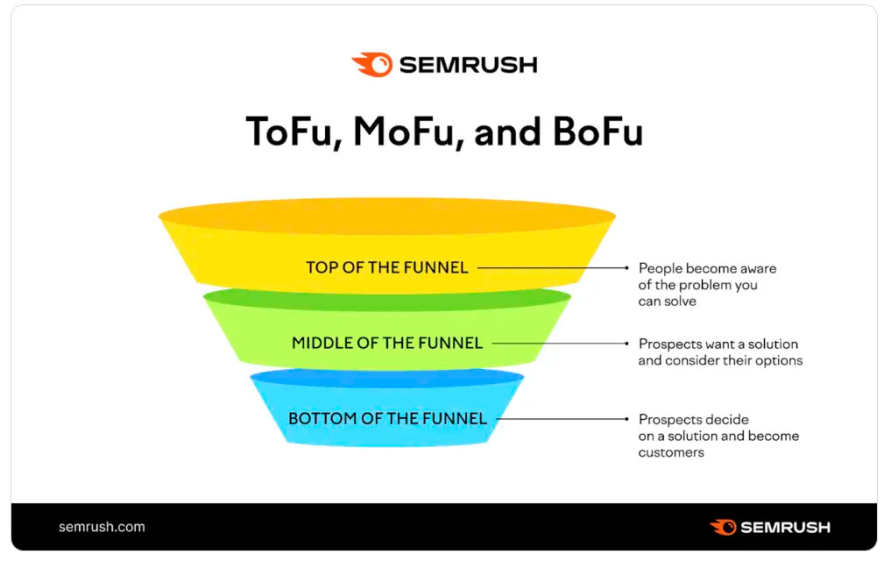
Let’s discuss how to assign various keyword types and content formats to each stage.
TOFU (Top of Funnel)
In Tofu, the goal is awareness. So, build awareness about your business or the problems your B2B business addresses.
Keywords here are informational, like “what is CRM software” or “benefits of cloud storage.”
In this stage, answer the question “What do I need?”
What type of content works in Tofu?
The goal with your content is to educate your target customers, not sell.
So, content formats like blog posts, guides, infographics, ebooks, or explainer videos work well.
Example: a blog post titled “5 Reasons Your Business Needs a CRM.”
MOFU (Middle of Funnel)
In Mofu, the goal is consideration. So, teach people how to choose a solution.
Keywords in this funnel are comparison or solution-focused, such as “best CRM tools for small business” or “CRM vs ERP.”
In this stage, answer the question “Why do I need it from you?”
What type of content works in Mofu?
The goal here is to provide people with options for comparing features, benefits, pros, cons and pricing.
So, content formats like case studies, webinars, whitepapers, and comparison reviews work better.
Example: a comparison guide on “Top 10 CRM Tools for Small Businesses Compared.”
BOFU (Bottom of Funnel)
In Bofu, the goal is consideration (or decision). So, explain why your B2B product is the best solution.
Keywords are transactional or branded, like “HubSpot CRM pricing” or “Zoho CRM free trial.”
In this stage, answer the question “Why should I buy it now?”
What type of content works in Bofu?
Here, people are looking to make a purchase. So, create content that makes people trust you or take action.
Content formats such as demos, free trials, product pages, or customer testimonials work well.
Example: A demo page like “HubSpot CRM free trial signup”
Mistakes to Avoid in B2B Keyword Research
Here are some of the common B2B keyword research mistakes to avoid in 2026.
Mistake #1: Targeting broad keywords
- Example: Using “CRM” instead of “CRM software for small law firms.”
- Fix: Target long-tail keywords that are highly relevant to your target audience.
Mistake #2: Not analyzing competitors
- Example: Not identifying what keywords your competitors rank for.
- Fix: Use tools like Ahrefs or Semrush to identify keyword gaps.
Mistake #3: Targeting negative keywords (in PPC)
- Example: If you sell paid CRM software, stop paying for paid ad searches like “free CRM tools.”
- Fix: Add terms like “free,” “open-source,” “trial download” as negative keywords.
Mistake #4: Targeting only one keyword
- Example: Optimizing a page just for “B2B marketing software” and ignoring keyword terms like “B2B marketing tools for startups” or “enterprise B2B marketing solutions.”
- Fix: Use related and semantic keywords using tools like Semrush
Mistake #5: Ignoring content quality
- Example: Creating a blog post to target just a few keywords like “top B2B software” but not offering any real value
- Fix: Focus on creating highly informative content with real-life examples, facts, and stats
Final Tips for a Winning B2B SEO Strategy
- Always choose keywords that indicate buyers are almost ready to make a purchase. Make sure to identify your ideal customer and analyze their pain points.
- Match keywords to each buyer’s stage: awareness, consideration, and decision.
- Identify and analyze your competitor keywords to find better keyword ideas.
- Don’t just go after high-volume keywords; always consider the intent behind each keyword.
- Try to target long-tail keywords as much as you can, as they can send you relevant traffic and have less competition.
FAQs | B2B Keyword Analysis
Here are some of the commonly asked questions on B2B keywords.
Identify your ideal customer, use tools like Semrush or Ubersuggest to find relevant terms, and map keywords to the sales funnel (TOFU, MOFU, BOFU).
B2B SEO is all about optimizing your website’s content so businesses can find your products through search engines like Google.
B2B research involves analyzing the latest market trends, competitors, and the needs of buyers.
Yes, SEO helps with attracting the right customers, leads, and visitors to your B2B business.
